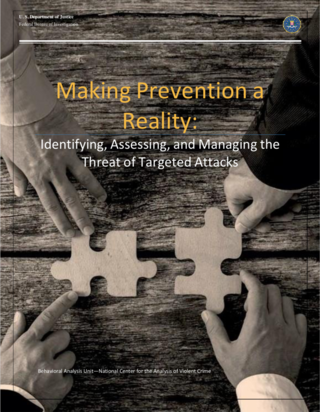Leadership
Mass Shootings and What You Can Do About Them
What you can do to stay safe and help prevent these horrors.
Posted November 10, 2018
Every day in America, acts of targeted violence are carried out against innocent people simply being at home, going to work, attending church or having a drink. The frequency of public mass shootings has impacted the entire nation. Many Americans feel that there are no safe places. One recent Facebook post listed the following events on a graphic that had received thousands of views and comments.

What a shame to truly live life being so afraid to engage in our everyday activities. While the frequency of mass shootings has certainly increased in recent years, the likelihood of being a victim of a mass shooting is extremely low. While it is critically important to take measures to prevent and mitigate the impact of these heinous acts, we must not allow them to steal our enjoyment of life.
So, what can we do to stay and feel safe without barricading ourselves inside fortified homes and deleting the types of places that have been attacked from our list of activities?
Things to Consider to Protect Ourselves Against Mass Shootings
Physical Preparedness
Approaches to school security have been highly publicized, as have debates concerning facility hardening like fortified doors, cameras, bullet-proof windows, more armed school resource police officers, and armed teachers. Some schools have even installed smoke canisters in the ceilings that can be activated during an attack so the shooter can’t see potential victims. Many workplaces and government offices have highly restricted access and magnetometers. Many of these measures may be a deterrent to potential shooters and could save lives during an attack, but we can spend millions of dollars on these approaches and there will still be people killed in mass shootings even with those systems in place. In the recent shooting at Borderline Bar in Thousand Oaks, California, the killer first shot the security guards and then killed a responding sheriff before killing many others and killing himself.
Mental Preparedness - Situational Awareness
To stay safe, it is important to have situational awareness. Situational Awareness is the perception of environmental elements and events with respect to time or space, the comprehension of their meaning, and the projection of their future status. In other words, being mindful of our surroundings and having a plan of action if something bad goes down. Even without training, we can be more mindful about our surroundings without being overly anxious or afraid. Every time you get on a commercial airplane flight, a flight attendant asks you to find the emergency exit, know where the life jacket is and how to put it on, and notice where the lights are guiding you out if it is dark.
When in a public place, just take a look around and consider what you would do if someone entered with a weapon. It only takes a few seconds. Ask yourself, could I see the person come in? Where is the nearest escape route? Is there a place to hide? If I have to fight is there something I can use as a weapon? Many schools and some workplaces now prepare for these possible events with drills and active shooter training. Most people, however, don’t have access to that level of preparation and can simply become more situationally aware. Situational awareness and active shooter training along with higher physical security may save lives during an attack but unfortunately may not prevent mass shootings.
Gun Control
The debate over gun control continues to be a divisive issue in America. More required background checks and stricter regulation of some weapons and high capacity magazines could have an impact on reducing the kill rate during an attack as it probably did in the Borderline Bar attack. California, where that shooting occurred, has some of the strictest gun laws in the country. Except for approved law enforcement, the manufacture or possession of all assault weapons is prohibited. The shooter at Borderline used a handgun and not an assault weapon. He did, however, use a possibly illegal high capacity magazine that held a massive amount of ammunition. California also has required background checks with a waiting period. Stricter gun laws can save lives, but they will not prevent most of these types of mass attacks.
What can we do to prevent mass shootings?

For over 25 years The U.S. Secret Service, the F.B.I., other law enforcement agencies, academic researchers, and mental health experts have been conducting research and have implemented programs and strategies to prevent targeted attacks. Much of this work occurred as a response to assassination attempts on elected officials, the Columbine and Virginia Tech massacres, and other mass shootings. In 2017, a comprehensive compilation of the latest research and approaches to threat assessment was published. Making Prevention a Reality: Identifying, Assessing and Managing the Threat of Targeted Attacks is the result of a 2015 FBI symposium that brought together threat assessment experts from many professional fields.
According to this publication, the most promising approach to preventing mass attacks involves interventions with individuals who may be headed down a path toward violence.
“Intervention requires a strong commitment by organizations and communities to public safety and care-taking for those in need. This involves the adoption of policies and programs to support targeted violence prevention efforts, establishment of threat assessment and management teams, and education to underscore the importance of these processes and to promote acceptance and engagement by all. “
The FBI defines threat assessment as:
“A systematic, fact-based method of investigation and examination that blends the collection and analysis of multiple sources of information with published research and practitioner experience, focusing on an individual’s patterns of thinking and behavior to determine whether, and to what extent, a person of concern is moving toward an attack. A threat assessment is not a final product, but the beginning of the management process. It guides a course of action to mitigate a threat of potential violence. Merely identifying that someone is of moderate or higher concern, without developing a management strategy, does not complete this process and is not recommended.”
By engaging in the assessment and management process as soon as a person of concern is identified, threat managers are more likely to succeed in preventing a violent outcome. Guiding a person in a different direction early on may mean offering assistance to someone who needs it before that person concludes violence is necessary.
Threat Assessment as a prevention strategy is relatively new and it has not gotten nearly the attention or funding that site protection, armed guards, and active shooter training have received, even though there is much anecdotal evidence that the approach has been effective in preventing many mass shootings.
There is now a bill working its way through the U.S. Congress that goes beyond political rhetoric to provide a national strategy to keep communities safe from targeted violence. The Threat Assessment, Prevention, and Safety (TAPS) Act (H.R. 6664) was introduced by Representative Brian Babin of Texas.
The TAPS Act creates a task force of subject matter experts who will assist in creating a national strategy to prevent targeted violence through threat assessment and management. The national strategy will provide resources, training, and assistance in establishing and operating locally-driven multidisciplinary threat assessment and management units as well as a specialized school threat assessment program.
The passage of this act would be a significant step in preventing many mass attacks. If you want to do something to help prevent mass shootings, let your U.S. congressional representative know that you support this bill.
For more information about Threat Assessment visit the Association of Threat Assessment Professionals (ATAP) website at www.atapworldwide.org.




